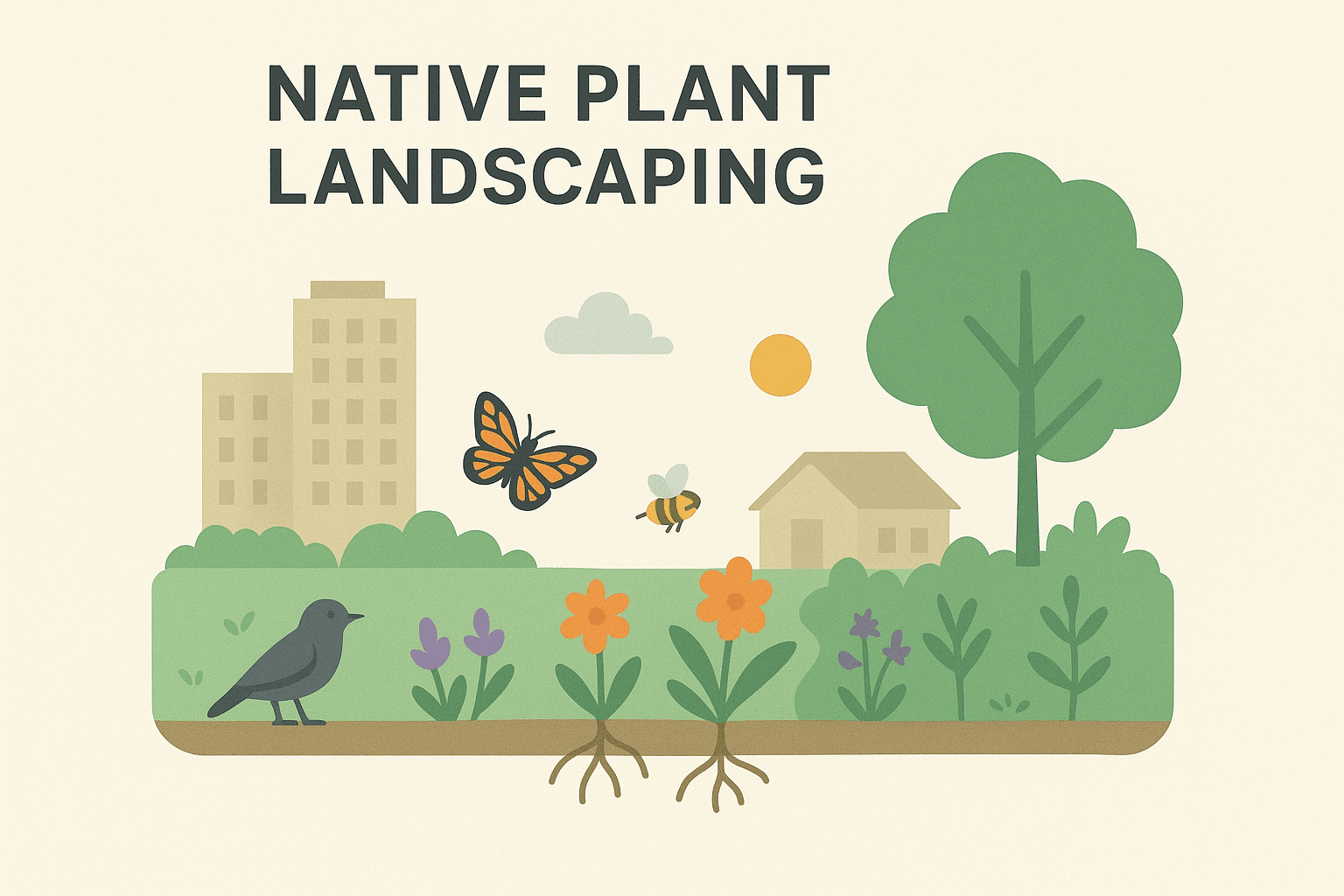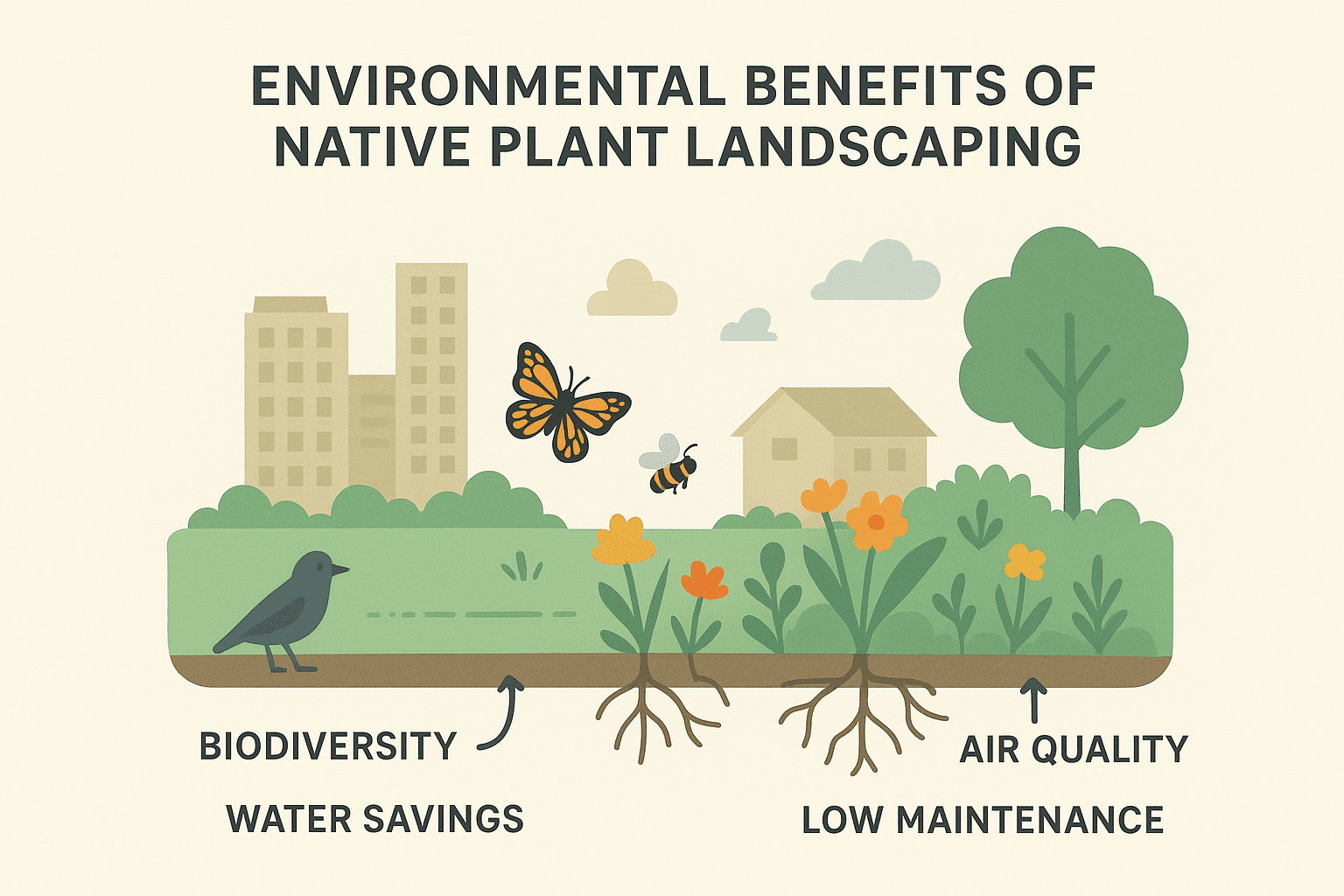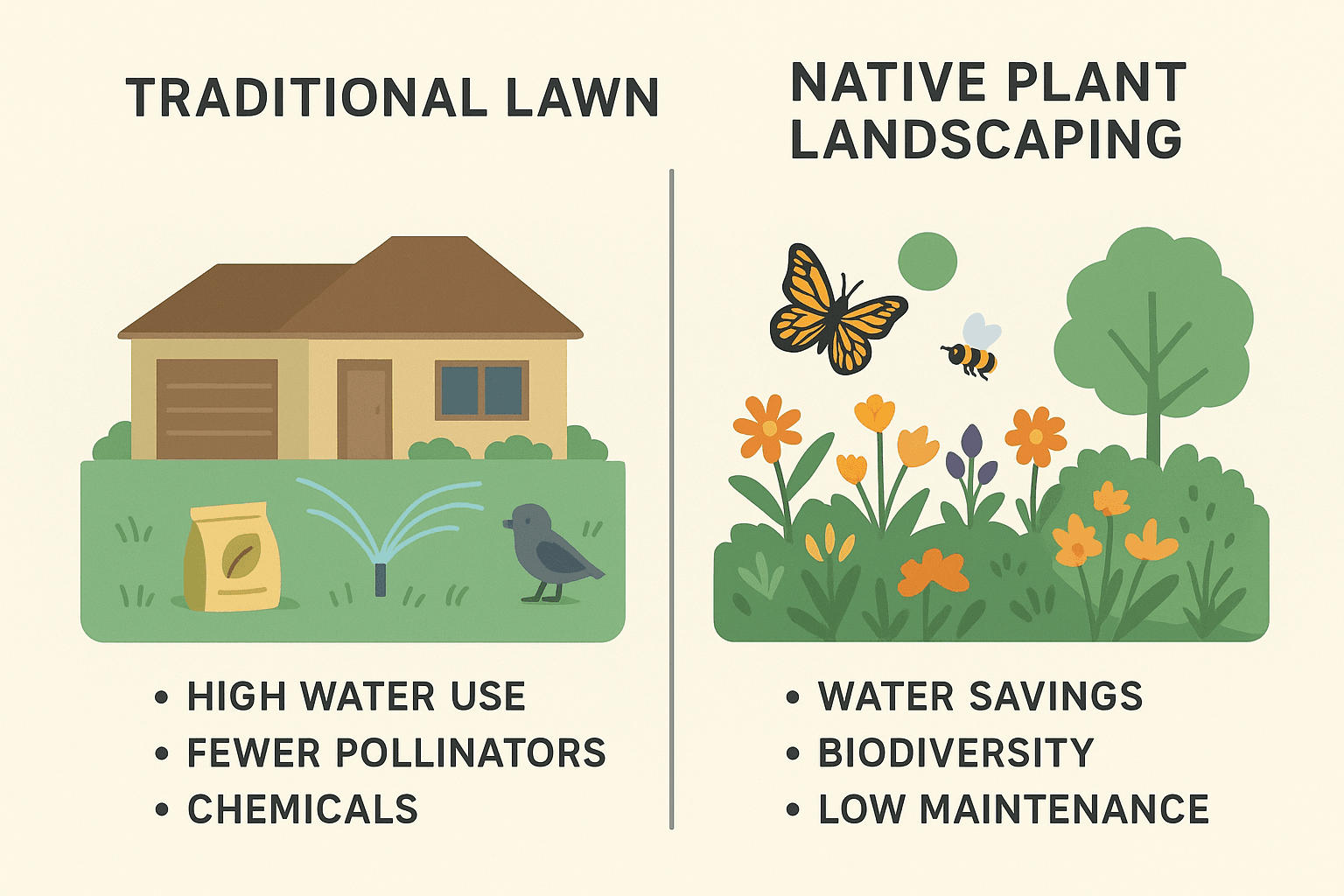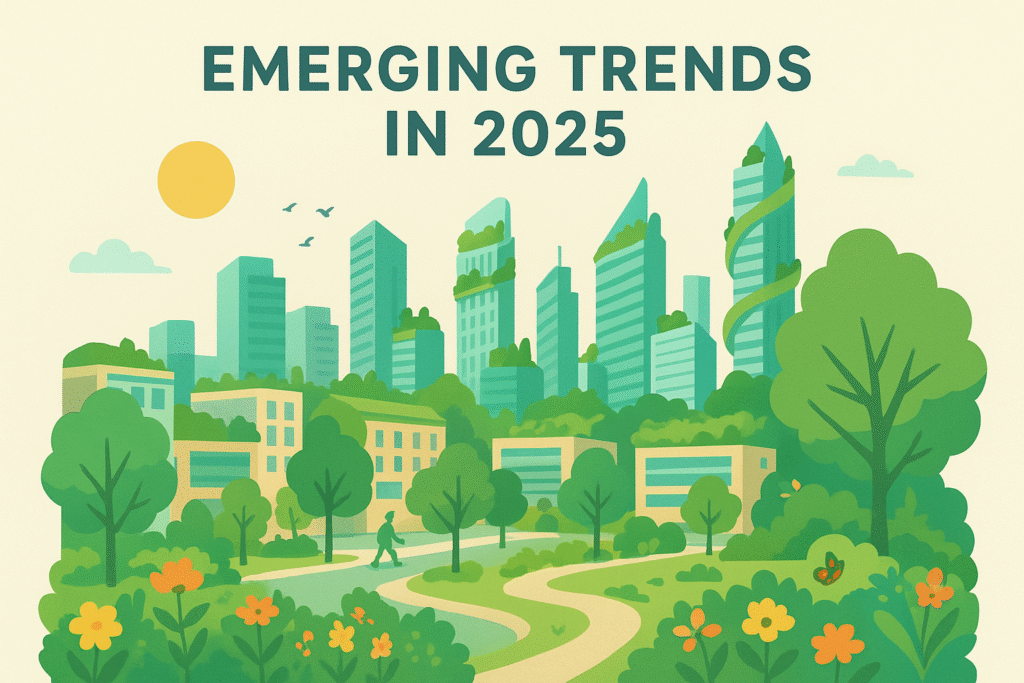
Table of Contents
ToggleWhy Native plant landscaping matter?
Model cities are often seen as landscapes of concrete, glass and asphalt. But within every balcony, rooftop or small backyard an opportunity is hidden to create something greener, healthier and far more sustainable. These opportunities are offered by native plant landscaping. It is not just about planting greenery, it’s about re-establishing a living connection between urban homes and the ecosystems.
Unlike exotic ornamentals, native plants are already adapted to local rainfall, soil conditions and seasonal changes. This makes them naturally strong in cities where water shortages, rising temperatures and limited space are common challenges. Urban homeowners can reduce the need for fertilizers, pesticides and constant watering by choosing native species. They create landscapes that are both low-maintenance and resource-efficient.
But the impact of native plant landscaping goes beyond convenience. These plants attract pollinators, provide habitat for urban wildlife and help to restore biodiversity that cities often lose during development. It is more than just a garden, it means living in an environment that supports cleaner air, cooler temperatures and healthier communities.
Using native plants is about making a balance. Native landscapes thrive where traditional lawns struggle to survive. They make our cities more livable, resilient and connected to the rhythms of nature. This blog will explore the various benefits of native plant landscaping, including economic, health, and climate benefits.

Environmental benefits of native plant landscaping
One of the biggest strengths of native plant landscaping is its ability to heal the environment in crowded cities also. When urban homes adopt native plants instead of foreign ornamentals the positive impact becomes visible.
Restoring Urban Biodiversity
Cities often displace birds, butterflies, and insects that once dominated the area. Native plants act like a welcome mat for these species. Their flowers provide nectar for pollinators, their seeds feed birds and their leaves support insects like caterpillars. Your rooftop garden or a small yard that is filled with native plants can become a mini habitat. It can stitch fragmented ecosystems back together.
Reducing Water Waste
Urban landscapes typically use large amounts of water to keep lawns and exotic plants alive. But on the other hand, native plants are adapted to local rainfall patterns and soil types which is why they can grow with minimal irrigation after their establishment. This makes native plant landscaping a practical solution for cities where water scarcity is increasing.
Improving Soil Health
The deep root systems of native species stabilize soil, reduce erosion and allow rainwater to soak in instead of running. It replenishes groundwater and also prevents flooding by reducing the burden on city drainage systems. Over time, these roots build richer & healthier soil that continues to support life.
Cleaning Air and Filtering Pollution
Urban areas often struggle with air and water pollution. So, Native plants can act as natural filters for them. These plants trap dust, absorb CO² and even filter pollutants from rainwater before it reaches storm drains. This quiet cleaning service improves environmental quality in our surroundings.
Cooling the Urban Heat Island
Concrete and asphalt trap heat and make cities several degrees hotter than nearby rural areas. These plants can be used to shade heat-absorbing surfaces by which homes and streets more comfortable during hot summer days.
In short, native plant landscaping doesn’t just make cities look greener, it also rebuilds the natural systems that urban life has lost. Every native plant is a step towards a healthier and more balanced ecosystem.

Economic Benefits of native plant landscaping
The beauty and ecological value of native plant landscaping are clear but its economic advantages are often underestimated. For homeowners in cities who choose native species can directly save money and resources.
Traditional lawns and exotic plants usually demand constant attention like regular watering, expensive fertilizers, pesticides and frequent mowing. All of these add up to high utility bills and ongoing maintenance costs. On the other hand, they are already adapted to local climate conditions. They thrive with minimal watering and require little or no chemicals with rarely demanding need for replacement. Over the year, this can reduce household landscaping expenses.
Energy savings are another hidden benefit. When native trees and shrubs are placed strategically then they can provide natural shade in the summer and wind protection in the winter. This reduces reliance on air conditioning and heating which results in lowered energy bills while keeping homes more comfortable.
In cities, the wider adoption of Native Plant Landscaping can also ease the financial strain on public infrastructure. Healthy native root systems absorb stormwater more efficiently to reduce the cost of managing urban flooding and maintaining drainage systems. Native landscaping proves that sustainability is not a luxury it’s a smart financial choice. Urban households gain a landscape that is both eco-friendly and economically efficient by reducing ongoing costs and conserving resources.
Health and social benefits
The benefits of native plant landscaping are extended beyond the environment and economy by touching human lives directly. In crowded urban settings where stress and pollution are daily realities, these native plants can play a surprising role in improving health and community well-being.
Green spaces with native plants offer a natural stress reliever for individuals. Studies have shown that spending time around greenery lowers blood pressure, reduces anxiety and improves overall mood. Native plants remain healthy and vibrant throughout the seasons because they are well-suited to local climates.
Air quality is another key factor. Native plants absorb pollutants and trap dust particles which helps to create cleaner air for city dwellers. When their ability is combined to reduce heat, they contribute to more comfortable living conditions that are particularly important for vulnerable groups like children and the elderly.
On the social side, native landscapes encourage people to come together. Community gardens, shared courtyards or even neighborhood initiatives that focus on local planting foster interaction and cooperation. They give a sense of pride and belonging to residents. Native plants landscaping doesn’t just make cities greener- it makes them healthier, friendlier and more livable for everyone who calls them home.

Resilience benefits
Today cities face rising temperatures, unpredictable rainfall and extreme weather. Yet, Native plant landscaping can offer homeowners a natural way to make their surroundings more resilient against these climate challenges.
Native plants are built to handle the conditions of their region. They survive with little water in drought-prone areas and in flood-prone cities, their deep root absorb and filter stormwater which reduces the risk of waterlogging. This means they act as loving defenses for urban homes.
Another benefit is temperature control. Dense Greenery shades walls, pavements and rooftops which helps to cut down the urban heat island effect. Homes that are surrounded by native landscaping stay cooler in summer months and it reduces the need for air conditioning.
Strong root systems also protect against soil erosion and improve water infiltration which is crucial during heavy rains. These plants ease pressure on city drainage systems by keeping soil in place and letting water soak in. In short native plants aren’t just garden choices- they are allies in adapting to climate change. They make urban homes safer, cooler and better prepared for upcoming challenges.
Overcoming Urban Hurdles – Tailored Solutions
Benefits of native plant landscaping are clear but city dwellers often wonder how this can work in small & crowded spaces? The answer lies in smart and tailored solutions. Limited space can be turned into green patches with vertical gardens, balcony planters and rooftop landscapes. Even small courtyards or parking strips can host native ground covers or shrubs. Every square foot matters.
Another hurdle is the belief that native plants look “messy” compared to manicured lawns. But with thoughtful design (mixing seasonal bloomers, evergreen shrubs and ornamental grasses) native landscapes can be tidy and attractive both. According to the U.S. EPA, in many urban areas up to 30 % of water use (on the East Coast) and 60 % (on the West Coast) is for lawn irrigation.
Water and maintenance pressure are very common. Yet, they demand less care than exotic species after establishment. To make it easier, use drought-tolerant varieties and group plants with similar needs. Policy and awareness can also be Challenges. Homeowners’ association or city rules sometimes favor uniform lawns. And that’s why, spreading awareness of the long-term benefits and showcasing successful native landscapes can slowly change perceptions.
Most urban settings can embrace native plants by blending creativity, patience and community support. With every balcony garden or pocket park our cities move one step closer to greener & healthier living.
Faqs
Why is Native Plant Landscaping better than using exotic plants in cities?
Native plants are adapted to the local climate and soil which means they need less water, fertilizers and maintenance. Unlike exotic species, they also support local pollinators like bees and butterflies which helps to restore urban biodiversity.
Can Native Plant Landscaping really reduce costs for homeowners?
Yes. Because native plants are naturally resilient, they require less irrigation, pesticides and upkeep. This reduces water bills and maintenance expenses which makes them cost-effective in the the term.
Is Native Plant Landscaping practical in small urban spaces?
Absolutely. Even balconies, rooftops or tiny front yards can host native shrubs, grasses or container plants. These small additions still improve air quality, attract pollinators and make city living healthier and Greener.
